

Adaptive Reuse and Senior Living CONNECT


CONNECT
About the Series
During the past few years, we all have felt the sting of disconnection and the senior living sector is not an exception. Whether institutional inertia, the increased use of technology, or the pandemic long shadow, our priorities have shifted. Now we can concentrate on getting back to our established past, and to plan and leap forward to a future built on meaningful and intentional connections. Our CONNECT series will explore a number of ways the senior living sector can strengthen, create, or reinvest in those bonds that connect us. Throughout 2022, we will look at the emotional and social elements that bring us together as communities, the physical spaces that invite and encourage interaction, the technology that unites rather than isolates, and the organizational missions that drive our collective passion as planners, operators, and change-makers. Join us in this journey to CONNECT.
Key Takeaways
Several factors are influencing the growing interest of the reuse and adaptation of existing structures. Post-pandemic increased availability of office buildings, hotels, etc., changing preferences of older adults, and the “forgotten middle” financial challenges are just some of the factors impacting this market sector. The Perkins Eastman senior living team is exploring opportunities with clients, developers, and multiple organizations to evaluate and implement residential projects and services on existing sites and structures that provide the right solutions for specific markets and locations. It requires a diverse team of creative talents to find and execute these opportunities.


Adaptive Reuse and Senior Living
CAN EXISTING BUILDINGS PROVIDE AN INTEGRATED, AUTHENTIC AND VIBRANT LIFESTYLE FOR OLDER ADULTS?
It is commonly understood that adaptive reuse of existing buildings can be a viable alternative to new construction. Adaptive reuse is less disruptive in many ways, helping to maintain the cultural fabric of a community and promoting a circular economy by working with current infrastructure as opposed to demolishing and building new. Although there are always unique challenges in modifying the building systems of existing structures, sustainability is a major benefit to adaptive reuse. As Carl Elefante, former president of the American Institute of Architects, famously said: “The greenest building… is the one that is already built.”
Adaptive reuse projects are not new to Perkins Eastman. From a tenement building-turned-museum (Lower East Side Tenement Museum in New York) to an old cardboard manufacturing warehouse-turnedbiotech research laboratory and workplace (Smith + Nephew R&D and Medical Education Training Center in Pittsburgh), we have worked on many building transformations. This experience also extends to senior living.
Among other projects, we were early adopters of adaptive reuse, converting a convent and former school originally home to the Felician Sisters outside of Pittsburgh into an award-winning, LEED Gold-certified mixed-use complex featuring an assisted living residence for seniors and a learning environment for secondary school students.

Felician Sisters | conversion of convent to assisted living
Today, our teams work with our clients to analyze and test-fit a wide spectrum of building types to understand whether they are appropriate for converting to supportive spaces for aging adults. But in order to define how existing building stock and adaptive reuse may be a viable option for senior living, it is important to understand the changing preferences of older adults as well as the economic aspects of retirement. The Baby Boomers, long a generation that has challenged the status-quo, are objecting to the assumption that, after a certain age and upon retirement, they need to go to some ‘other’ place to age, living out their lives amongst a community of peers. In a recent article in The Wall Street Journal titled These Retirees Won’t Settle for Sleepy Suburbs— They’re Moving to the Big City, one retiree offers an opinion that who you interact with dictates who you become: “If you want to be old, hang around old people.”
Many would consider this type of thinking ageist. Given this thinking, what is the response of a design and building industry whose entire existence is based on the premise that older people prefer to hang around with other older people in buildings specifically suited to their needs (and apart from the larger, intergenerational community from which they came)?
Two mega-trends identified in Perkins Eastman’s 2019 white paper, The Clean Slate Project, “Third Act” and “Aging in the Community,” shed light on this paradigm shift. The Third Act trend represents adults who are looking for purpose-driven, postcareer experiences that are intergenerational, vocational/voluntarist, and vibrant. The trend towards Aging in Community challenges the merits of both aging in place in one’s existing home as well as relocating to a residence removed from the general population both of which can lead to isolation as one’s physical and social mobility deteriorates. Instead, this mega-trend advocates for intentional physical communities that are located within existing neighborhoods, towns, and cities where adults already live and thrive.
Developing new buildings ‘where the action is’ weaves senior living within the fabric of established communities, but can also be challenging and expensive. This is where our existing building stock enters the conversation.
Learning from Other Markets
While developers and entrepreneurs have been capitalizing on the benefits of adaptive reuse for decades it is difficult to find a city without a trendy apartment building located in a retired factory building, which then leads to additional business ventures old churches remade into breweries and restaurants, former-train stations reinvented as farmers markets the senior living sector is beginning to adopt this thinking to meet its needs. In parallel with the Third Act and Aging in Community trends, developers and architects are giving existing buildings a dynamic new stage of life, while maintaining a community fabric where they have existed for the better part of a century.
Senior living is not the first market sector to adapt existing buildings much can be learned from the residential and hospitality markets which have a long history of commercial conversions. The residential market in particular provides many examples of successful conversions of commercial buildings in urban centers. Beth Burnham Mace, chief economist at the National Investment Center for Seniors Housing & Care says, “Some developers are looking at converting unused office buildings and hotels, options increased by pandemic vacancies.” (As Baby Boomers Retire, Developers Bet Urban Senior Living Will Take Off, Wall Street Journal, 2022)
When these conversions are successful, developers see robust interest in re-imagined assets that have long been embedded within the community, from shopping malls and office buildings to hotels, schools, banks, and churches, etc. For senior living, we believe the following typologies present interesting potential.
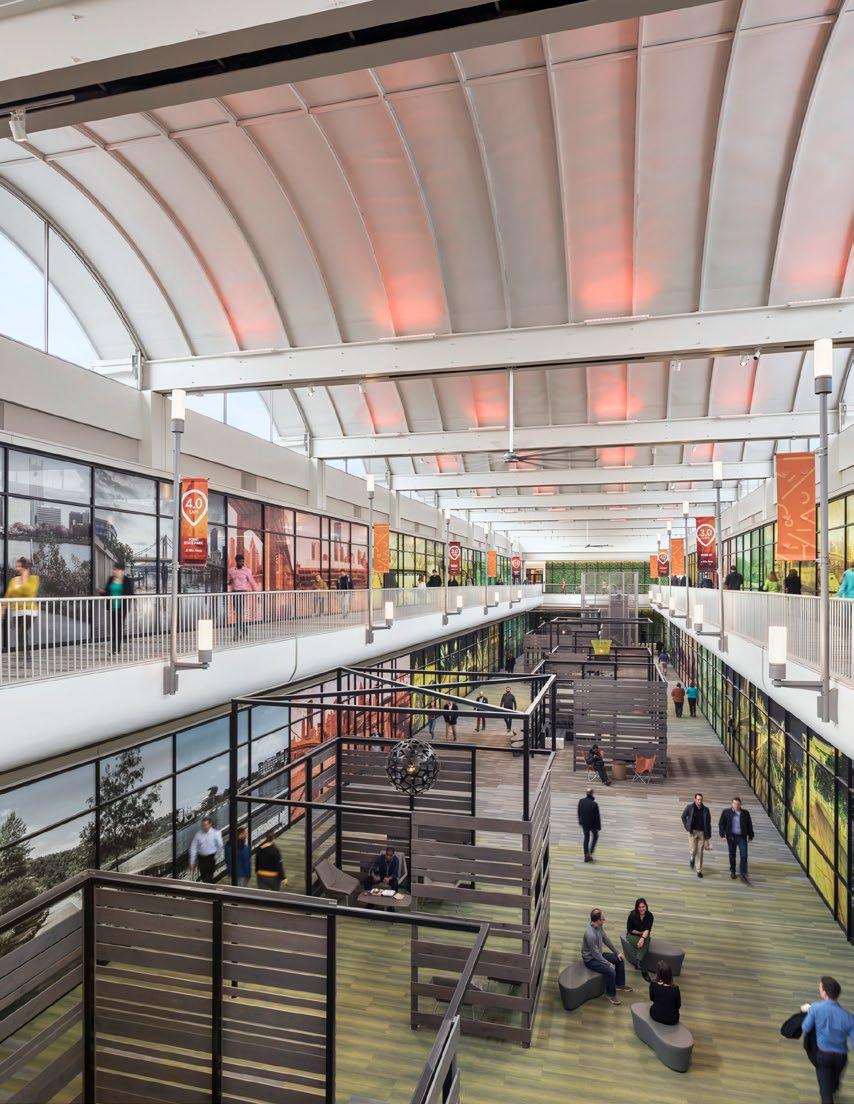

SHOPPING MALLS
Repurposing of shopping malls is expected to be an impactful trend through 2025.1,2 While many underutilized retail centers are razed and rebuilt as mixed-use developments, some are seeing new life with non-traditional tenants, such as community amenities like senior-friendly apartments, coworking office space, intergenerational daycare, makerspaces, retail, a public library and culinary facilities that serve double-duty as teaching kitchens for a local college and as a dynamic restaurant experience. (The Clean Slate Project, Perkins Eastman, 2019)
As defunct malls look for change within their walls, they are also looking to repurpose traditional “ring road” buildings that form their perimeter. Perkins Eastman client, Akara is creating an active adult community adjacent to the Southwest Plaza Mall in Littleton, CO, that repurposes previously developed space and under-utilized mall parking. ACTIV Littleton offers an abundance of amenities,
services and programming designed around the health and wellness of its residents and creates a strong sense of place, bringing human scale to the development’s exterior.
HOTELS
As senior living embraces a hospitality service model and aims to serve broader economic and lifestyle audiences, hotel conversions have become a popular concept one which gained particular interest as COVID-19 restrictions affected travel/ tourism properties. This trend favors conversions to market rate multifamily, student housing3 and government-funded housing and shelters, with a few developers specializing in converting hotels to senior living.
Suite-style hotels are easier to convert to independent senior living or active adult due to apartment size and potential existing services. Conversions to higher levels of care are more challenging because it requires bringing buildings up to applicable codes. Some examples include
Akara Southwest Plaza Littleton| conversion of retail to senior living
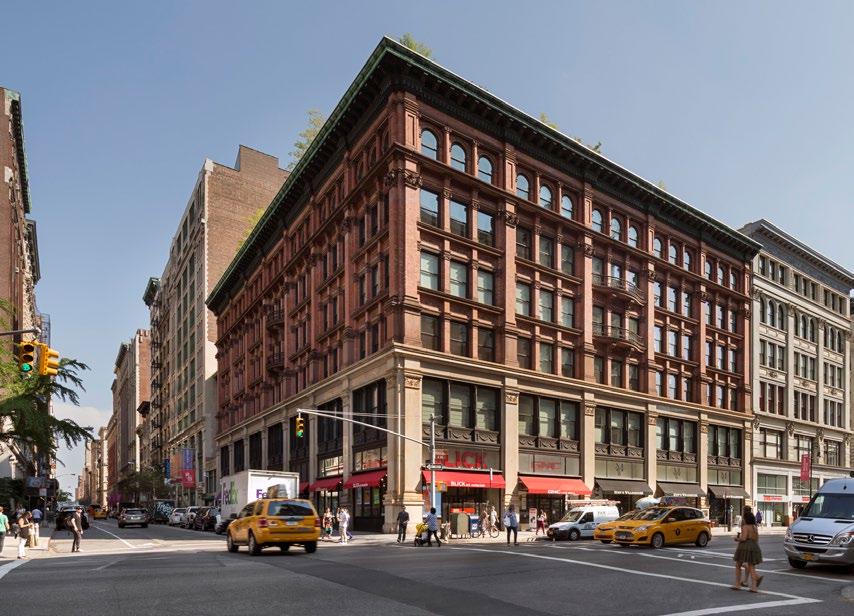
conversion of a former Sheraton Hotel in Fort Meyers, Florida, into luxury independent living apartments now operating as the Campo Felice,4,5 or a hotel/convention center in Dallas, Texas, that was converted into a life plan community now operating as Truewood by Merrill at Merrill Gardens.6
OFFICES
Office conversion projects typically trend toward market and luxury multifamily reuse. 650 6th Street in New York City is an example of a historically significant office building that was converted into condos. The exterior walls and structure remained, while a new core and penthouse floor were added. A deep floor plate meant long, skinny apartments, which required creative design and detailing to bring light and mechanical ventilation to interior
rooms. Conversion of office and commercial buildings to senior living makes the most sense when co-located or co-developed with services and amenities restaurants, gyms, medical centers within walking distance or within the same building.
INSTITUTIONAL BUILDINGS
Not as widely discussed, conversions of institutional buildings have seen success, especially in providing affordable senior housing in smaller communities and with missionoriented groups.
Outmoded institutional buildings, such as schools, which have sat dormant, ‘mothballed’ or underutilized as populations change, represent attractive opportunities. First, they are often economical with various affordable and historic
650 Sixth Avenue | conversion of office building to residential
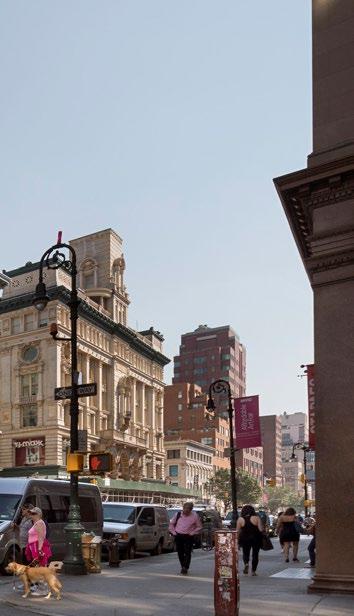
restoration tax credits full of character and well built. Second, communities are generally supportive of these projects because of the historical significance of the buildings. Finally, they help adults remain in their communities, staying invested in the places where they built their lives.7
Former skilled care buildings, hospitals, medical centers, and sanatorium-like institutions, with their ready layouts of plumbed rooms/units can be good candidates for conversions. For example, Perkins Eastman converted an existing floor in a medical office building into the Abramson Center: Lankenau Transitional Care Center in Wynnewood, PA, to provide a supportive healing experience focused on skilled care and rehabilitative services. Further, the St. Charles Hospital and Ravenswood Hospital, both in Chicago, Illinois, are examples of successful conversions to senior apartments, the

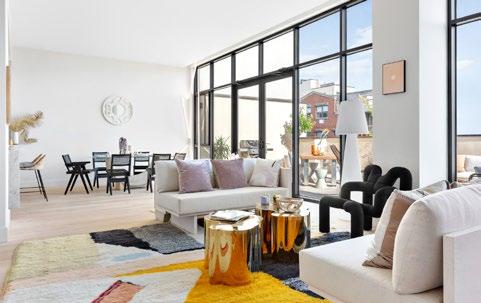
former building also received historic tax credits due to its placement on the National Register of Historic Places.8,9
Land-rich but cash-poor urban churches have also found ways to advance their social mission by capitalizing on underutilized property or facilities. Strategic partnerships with like-minded organizations can help congregations access the latent value of their facilities and land to further their mission. In the former Second Presbyterian Church in Newark, New Jersey, built in the late 1880s, Amazon-owned audiobook company Audible is using a historic church to house an engineering and development hub for 350 people. Though no changes were made to the historic exterior of the building; the adaptive reuse of the building includes new floors and mezzanines, and challenging structural and mechanical systems are
Bath Haus Greenpoint | conversion of bathhouse to residential
Abramson Center: Lankenau Center| conversion of medical office to transitional care
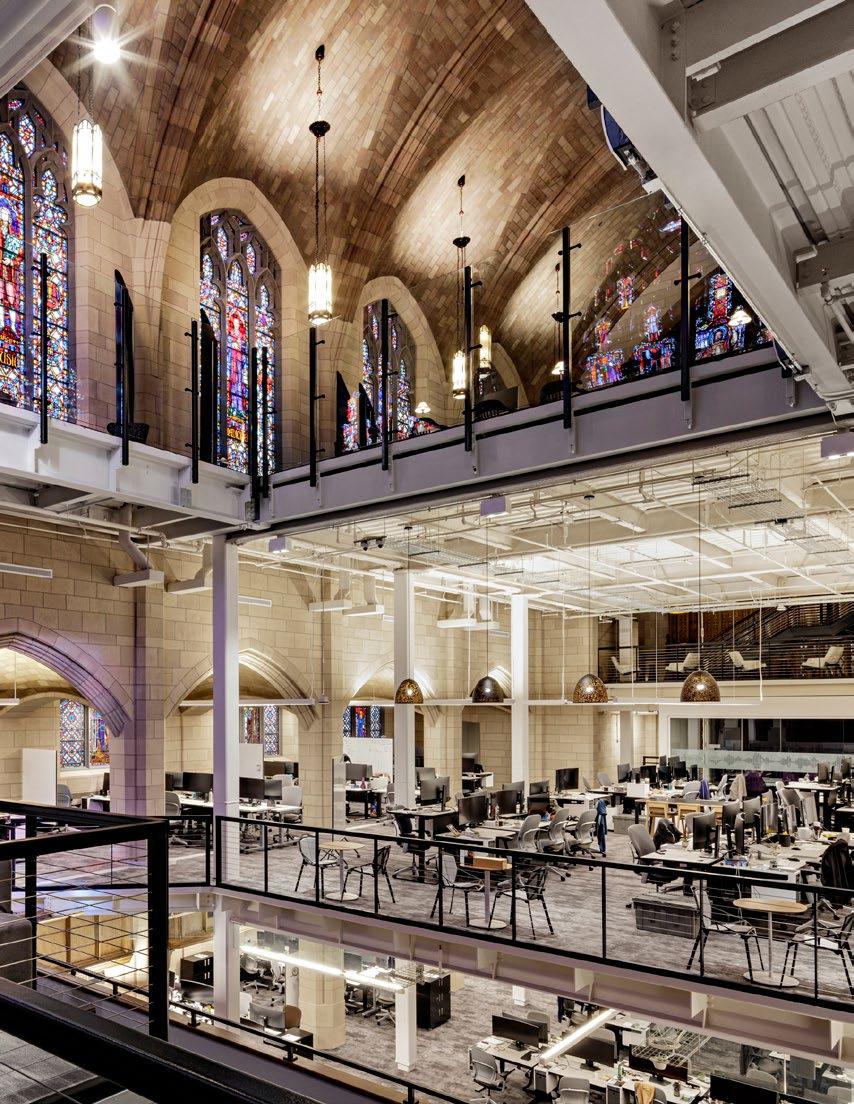
Audible: 15 James Street | conversion of church to office space
integrated to the core and shell to upgrade the long-vacant property for a high-tech user such as Audible / Amazon.
Finding the right building
When examining a building for reuse for senior living, there are certain building systems considerations to take into account. Ideally, the structural grid should be similar to the typical spacing of residential and senior living buildings to accommodate apartment modules. To ensure natural light and ventilation to all rooms, floor plates should not be too deep. The location of the core should provide easy access to all apartments from vertical (elevators and stairs) circulation. Lastly, the HVAC system should be able to be upgraded to the most efficient residential types with ability to control at the unit level.
Given these factors, certain building stock may not be well-suited for conversion to senior living. Some buildings may not be able to satisfy state licensing requirements without major modifications to elements such as hallways and vertical circulation. Additionally, in some jurisdictions, entitlements may be lengthy and difficult since a change of use is often required when adapting a building originally zoned as commercial.
As mentioned in the introduction, sustainability is one of the major benefits of reusing existing building stock, as it saves construction waste and reduces embodied carbon, (the carbon footprint of those materials already present in the existing building). Additionally, sustainability and wellness metrics, including LEED and WELL, typically have special provisions for reuse that can be easier to obtain than building new, further incentivizing smart reuse.
Embracing diversity in lifestyle and culture
Many successful and innovative examples of adaptive reuse showcase the benefits of convergence multiple markets coming together to create unique environments that offer lifestyle diversity. The WeWork: WeLive project in Arlington, Virginia, a conversion and repurposing of a 1960s office building into a mixed-use development with housing, office and retail, is one such example. The project combines living


Westin: One Main Place Plaza | conversion of office building to hotel by ForrestPerkins, a Perkins Eastman studio
Understanding the Boomer consumer’s desire to be where the action is, we might say that the most integrated, authentic, and vibrant buildings for older adults may be the ones that are already built.
and working spaces, and includes co-working offices on the uppermost two levels to provide the surrounding community with leasable co-working space. This work space allows for an intermingling of both the co-living inhabitants and those in the surrounding community. Projects like WeWork: WeLive that embrace convergence align well with the notion of the Third Act and the desire for intergenerational and cultural diversity.
Adaptive Reuse: Evolving Purpose
While there are many considerations to make when exploring existing building stock for senior living, thinking differently about how to repurpose and reinvent applying new ideas to age-old problems is precisely the dynamic and astute thinking we need. This creates opportunities to make better use of the buildings we have and pay homage to the people in our communities, addressing different markets and potentially making senior housing more affordable and inclusive moving forward. Understanding the Boomer consumer’s desire to be where the action is, we might say that the most integrated, authentic, and vibrant buildings for older adults may be the ones that are already built.
Discussion Starters
As a prospective resident and given the choice, would you rather move into a building that has been adapted to senior living housing if the location is in a vibrant existing neighborhood or community?
Would you consider an existing structure that could meet program and operational requirements in a micro-urban or urban location rather than a suburban “green field” site?
Would you consider an urban existing and adaptable structure/site for a satellite campus for your organization?
Would you consider partnering with a retail or office landlord or group to develop a senior living community?
Is active adult a better option for an adaptive use project?
Have you ever considered the concept of a “vertical Main Street” campus?
Authors

Alejandro Giraldo AIA
Principal
Stamford
+1 203 251 7435
a.giraldo@perkinseastman.com

Anthony Fusco AIA
Senior
Associate
Washington, DC
+1 202 495 7435
a.fusco@perkinseastman.com
Endnotes
1 Northspyre. (2021, August 30). The pandemic is making old buildings new again. Retrieved May 10, 2022, from https://www.northspyre. com/blog/pandemic-adaptive-reuse
2 Millard, B. (2021, November 8). Home sweet office: Commercial-to-residential conversions. AIA New York. Retrieved May 10, 2022, from https://www.aiany.org/membership/oculus-magazine/article/fall-2021/home-sweet-office-commercial-to-residential-conversions/
3 Mian, Q. (2020, July 28). It’s an optimal time for converting hotel assets to multi-family. Building. Retrieved May 10, 2022, from https:// building.ca/feature/its-an-optimal-time-for-converting-hotel-assets-to-multi-family/
4 Cirz, R. T. (2014, May 21). Retiring at the Ritz-a guest post from Llenrock group. Retiring at the Ritz-A Guest Post from Llenrock Group. Retrieved May 10, 2022, from https://www.irr.com/news/retiring-at-the-ritz-a-guest-post-from-llenrock-group-5691
5 Gerace, A. (2013, December 3). Former Sheraton Hotel slated for $55 million senior living conversion. Senior Housing News. Retrieved May 10, 2022, from https://seniorhousingnews.com/2013/12/03/former-sheraton-hotel-slated-for-55-million-senior-living-conversion/
6 Cirz, R. T. (2014, May 21). Retiring at the Ritz-a guest post from Llenrock group. Retiring at the Ritz-A Guest Post from Llenrock Group. Retrieved May 10, 2022, from https://www.irr.com/news/retiring-at-the-ritz-a-guest-post-from-llenrock-group-5691
7 Kimura, D. (2012, July 12). School conversions breathe life into affordable housing. Multifamily Executive. Retrieved May 10, 2022, from https://www.multifamilyexecutive.com/design-development/school-conversions-breathe-life-into-affordable-housing_o
8 Sudo, C. (2018, September 24). How adaptive reuse is helping create the senior housing of tomorrow. Senior Housing News. Retrieved May 10, 2022, from https://seniorhousingnews.com/2018/09/24/adaptive-reuse-helping-create-senior-housing-tomorrow/
9 Chicago Tribune. (2016, October 12). Transformation of historic former hospital in Aurora marks a milestone. Chicago Tribune. Retrieved May 10, 2022, from https://www.chicagotribune.com/suburbs/aurora-beacon-news/ct-abn-aurora-stcharles-1013-20161012-story.html
Image Credits
Page 1: Adobe Stock, © luciano
Page 2: © Chuck Choi
Page 4: © Perkins Eastman
Page 6: © Alexander Denmarsh
Page 8: © Perkins Eastman, photo by Sarah Mechling
Page 9: © Perkins Eastman
Page 10: © Perkins Eastman, photo by Sarah Mechling
Page 11 top: © Perkins Eastman
Page 11 bottom: © Glen E. Johnson
Page 12: © Ben Gancsos
Page 13: Adobe Stock, © Scott Griessel
Page 14: © ForrestPerkins

+1 203 251 7435

+1 412 894 8366
e.chmielewski@perkinseastman.com

b.fanta@perkinseastman.com
www.perkinseastman.com
